
Tales of the Faux Fuchsias
No, they're not real fuchsias. Someone just thought they looked like one.
A number of plants are often inaccurately called "fuchsias," of one sort or another. Perhaps it's because their flowers give an impression of the fuchsia's characteristic ones. Or maybe it's homesickness for lush cottage gardens left behind. Dry Australia seems especially prone to faux fuchsias. In addition to the many fuchsia wannabes of Oz, such as the Australian Fuchsia (Correa reflexa), are other plants like the Tree Fuchsia (Halleria placida) and the Cape Fuchsia (Phygelius capensis and P. aequalis, and their crosses, P. x rectus). The only faux fuchsia that might even remotely stake a claim to the title, though, is the California Fuchsia (Epilobium canum, formerly Zauschneria). This pretty species is also in the Evening Primrose Family (Onagraceae) and botanically closely related to the real thing.
No, they're not real fuchsias. Someone just thought they looked like one.
A number of plants are often inaccurately called "fuchsias," of one sort or another. Perhaps it's because their flowers give an impression of the fuchsia's characteristic ones. Or maybe it's homesickness for lush cottage gardens left behind. Dry Australia seems especially prone to faux fuchsias. In addition to the many fuchsia wannabes of Oz, such as the Australian Fuchsia (Correa reflexa), are other plants like the Tree Fuchsia (Halleria placida) and the Cape Fuchsia (Phygelius capensis and P. aequalis, and their crosses, P. x rectus). The only faux fuchsia that might even remotely stake a claim to the title, though, is the California Fuchsia (Epilobium canum, formerly Zauschneria). This pretty species is also in the Evening Primrose Family (Onagraceae) and botanically closely related to the real thing.
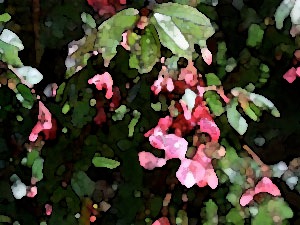
It seems appropriate to start this page of faux fuchsias with this particular genus. And this particular species in that genus. Although not using the fuchsia-like Begonia fuchsioides, our own Father Charles Plumier christened the first Begonia along with the first Fuchsia during his botanizing on the island of Hispaniola. The name was a nod to honor Michel Bégon, former governor of the French Antilles from 1682 to 1685. He was subsequently superindendant of the important French port of Marseilles, Plumier's hometown, from 1685 to 1689. Bégon was also a passionate plant collector. With over 1,500 species, Begonia is now one of the largest genera of flowering plants. Begonia fuchsioides, originating in Mexico not Hispaniola, is a shrub begonia with cane-like branches elegantly arching upwards to two to three feet in height and small leaves that lend it a fern-like appearance, a bit similar to its compatriot fuchsias in the Encliandra section. Like most begonias, it prefers an evenly-moist position in bright shade. Its pink to red flowers hang gracefully from the stems and are borne most of the year. Besides summer bedding, it also takes well to pot culture and will easily overwinter in a favorable spot indoors.
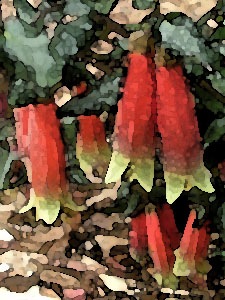
Correa is a genus of about eleven species, mainly native to Eastern Australian, named in honor of the Portuguese botanist José Correia da Serra (1750-1823), also known as Abbé Correa. The various species hybridize easily with each other naturally so there is quite a bit of taxonomic confusion between them. Originally discovered at Adventure Bay in Tasmania, Correa reflexa was described by botanist Jacques LaBillardière as Mazeutoxeron reflexum in 1800 but quickly transferred to the genus Correa by Étienne Pierre Ventenat in 1803. "Australian Fuchsias" are easily grown, three to four foot tall evergreen shrubs for a semi-shaded spot with good drainage in a Mediterranean-climate garden. They're probably hardy down to about the mid 20's. They're also drought tolerant once established but do like some summer watering to perform their best. Grown as single specimens or in groups, Correa have a long blooming season. They're also good as pot plants. They respond well to pruning to keep them in shape and so can be grown in containers on patios or in climates too cold for them to overwinter in the ground. There are now a significant number of attractive cultivars available.
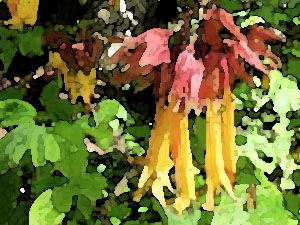
The tale of this most beautiful of the faux fuchsias is truly amazing; It was just a chance seed collection away from anonymous extinction. Dennis Breedlove, a botanist whose name should be very familiar to any fuchsiaphile, discovered this member of the coffee family (Rubiaciae) growing in a single location at 2,100 meters (6,900 feet) in the cool mountain forests of Chiapas in southern Mexico, He was on a botanizing expedition in the area in 1976. When he returned to the spot just ten years later, the land had been cleared for farming and the lovely "Golden Fuchsia" was gone. Almost. Luckily, the seed Breedlove had collected in the original chance encounter was successfully germinated and grown on. Today, the plant survives and thrives in botanical gardens and collectors' troves and luckily, like most real fuchsias, it's easy to grow given the right conditions. This multi-stemmed shrub reaches to about 6-8 feet (2-3 m) tall, or perhaps more. Its ribbed leaves are evergreen and have an attractive iridescence. The flowers are abundant and held in panicles at the ends of thin, wirery stems. Interestingly, again like most fuchsias, it prefers the cooler temperatures of the higher-elevation temperate cloud forests, and will not thrive where the climate is consistently hot and humid. Otherwise, it's easily grown in the ground in semi-shaded, frost-free locations—there's still a debate over just how much frost it might tolerate or not—or in a preferably large pot in colder climates. Even easily indoors if the right conditions are supplied. The plant is still a bit pricey and fairly rare in the market, but if you can get it, it would find an appropriate home among the fuchsias in your collection. Certainly, if you've ever been fortunate enough to see it growing and flowering in its full splendor, you'll be smitten. It earns its common name "Golden Fuchsia" with little resistance. Like some living medieval momento mori, it should also serve as a constant reminder of the supreme importance of ecological conservation since the world came so close to losing this lovely plant without ever knowing it. Deppea splendens briefly became Csapodya splendens (Breedlove & Lorence) Borhidi in 2004 (Acta Bot. Hung. 46: 82 2004) but then went back to Deppea..
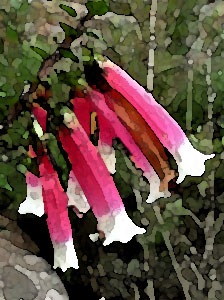
Epacris longiflora is an Australian plant belonging to the Ericaceae, or Heath Family, with a native range extending from the central coast of New South Wales to southern Queensland. It's an erect or low spreading shrub, sometimes described as straggly, from about two to five feet high found growing in full sun in poor-quality sandy coastal or sandstone soils, cliff faces, heath, woodland margins, and dry forests generally of eucalypts, wattles and banksias (sclerophyll forests). The striking and very showy, narrowly long tubular flowers, that give this Epacris its specific epithet, are red with white tips. At first, the flowers are held straight out at a ninety-degree angle down the branches but then become more pendant as they age. Flowers are borne on these attractive plants for most of the year, as well. The small, sharply pointed leaves are tightly packed along the wiry stems and are evergreen. "Fuchsia Heath" is hardy from Zones 8-10 and tolerates some frost. It also responds well to light pruning, which produces more compact growth at the expense of it gracefully arching natural habit, however, and is suited to container culture for patios or colder climates. However, this species is not often found for sale in suitable climates as its particular soil and drainage requirements can make it tricky to grow out in the garden outside of its native range.
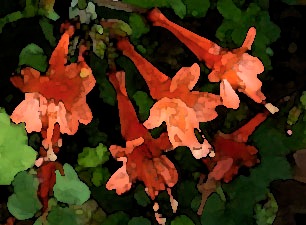
The various Zauschneria species were all recently reclassified by botanists as Epilobium canum, with only three still being recognized as subspecies. Of all the fuchsia fakes, though, the "California Fuchsia" probably has the most legitimate claim to the title. Its flowers don't just resemble those of the true fuchsia by accident. They actually do belong to a related genus in the same Evening Primrose Family (Onagraceae) as their namesake and, if you look closely, you'll see the same basic structure common to all family members. The attractive racemes of tubular, bright orange-red or scarlet flowers are generally borne in profusion in late summer and autumn. It's native to the dry slopes and dense, scrubby chaparral of the western United States, especially those of California. A mounding or matting perennial sub-shrub to half a meter tall, it spreads by tuberous rhizomes. Since it requires well-drained conditions in a full-sun position as befits it origin, it's often an ideal addition to dry, water-wise gardens and xeriscapes. The species is variable in both the flowers and leaves so there are quite a number of selections available from nurseries or other sources.
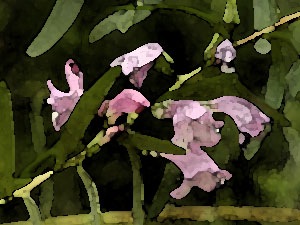
Endemic to Australia, Eremophila maculata's generic name derives from the Greek eremos meaning "desert" or "lonely place," and philos meaning "love." And that's exactly where the "Wild Fuchsia" is found: Imagine dry watercourses cutting through arid landscapes of blood-red dunes stretching out in every direction as far as the eye can see but overhung by graceful, weeping trees. These are places where man can barely survive but the Eremophila seems to take in stride. The edges of almost every salt lake, every dry watercourse and every clay pan in the arid wastes of inner Australia seem to have their ribbons of Eremophila maculata in various sizes, shapes and flower colors. Most occur in these semi-arid and arid regions growing in their deep sands and rocky, gravelly loams with neutral to alkaline pH. Once established, they are very drought tolerant and rarely require watering. They're even capable of surviving for extended periods of one to two years without rainfall so it's not surprising that other common names include "Poverty Bush" and "Desert Pride." Eremophila maculata ranges from being a dwarf to medium-sized shrub, less than two feet tall, to about nine feet tall by three to nine feet wide and is noted for its variation in flower color and growth habit. It has a dense growth with rigid branches and flower colors shade from off-white to deep pale pink, red to purple-red, yellow or even orange, often with a pale spotted throat. Flowering occurs mainly through the winter and spring seasons but some may occur at other times of the year as well. It's been in cultivation in the British Isles since as early as 1820 and is a relatively frost-hardy plant for a well-drained position in full sun to light shade in the Mediterranean-climate garden. A sister species, Eremophila decipiens, is known as the "Slender Fuchsia" while another, Eremophila freelingii, is called the "Limestone Fuchsia" or "Rock Fuchsia Bush."
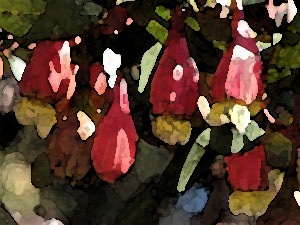
Eucalyptus forrestiana, also known as Forrest's Mallee or Forrest's Marloc, is a small tree native to an area near Esperance in Western Australia. It's a multi-branched mallee Eucalyptus with smooth bark growing from between five to twenty feet tall (1.5-6 m). Flowers appear between summer and winter. It's exceptionally beautiful when in bloom and the bright scarlet-red buds and pendant yellow blossoms really do make it look like numerous fuchsia flowers are hanging from its branches from a distance. The pods are attractive, as well, remain on the tree for months after flowering and the branches are often cut or dried for indoor decoration. The "Fuchsia Gum" is rather low maintenance, drought tolerant once established, and resistant to wind and some clay in soil, though the soil should still be well-draining. This tough plant also makes a good street tree in favorable climates. It matures to a rounded shape and is frost hardy from 23-27°F (-5-3 C).
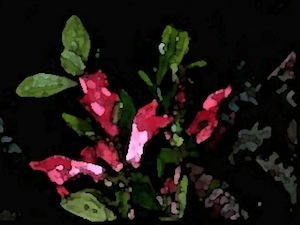
In the great tradition, it seems, of celebrating everything in Australia as a fuchsia of this kind or that, here’s another: Presenting Graptophyllum excelsum, now appearing in the role of the "Scarlet Fuchsia." She’s a bit of a diva, though, and some refer to her as the “Prickly Fuchsia” behind her back. One wonders where this Australian penchant for faux fuchsias came from. Perhaps borne from primeval memories buried deep in the land itself to regain what went extinct many millions of years ago, even if in name only. Or thoughts of fuchsia-draped cottages left forever behind in England in the harsh sun-baked expanses of the new land? Of course, I can understand. Fuchsias really are that memorable and unforgettable. However it might be… the real Scarlet Fuchsia is actually Fuchsia coccinea from Brazil. Nothing prickly about that one, either. Native to limestone-rocky hillsides from Cairns to Gladstone on the Capricorn Coast of Queensland, Graptophyllum excelsum is often thought to be an Eremophila, another fuchsia imposter, so I guess it’s a case of double-confusion. This attractive shrub of the Acanthus Family will grow fairly rapidly to about 5-15 feet (1.5-5.0 m) with full sun in a well-draining with good moisture and the upright growth can be pruned. The spectacular red, tubular flowers are held at the ends of the branches on in the axils. It will also withstand light frosts so it’s perfect for many gardens in a Mediterranean climate.
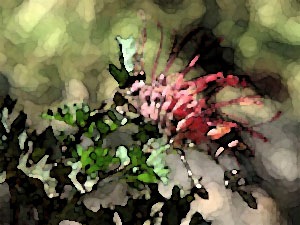
Yet another fuchsia pretender, Grevillia bipinnatifidia is from Australia. I don't know what it is about down-under that seems to produce so many wanabes. It's not like the real thing doesn't grow there, and grow there it does very well. But the Australians seem to have a hankering to tag anything even remotely similar as a "fuchsia." Go figure. The "Fuchsia Grevillea is a member of the Proteaceae Family, which includes such relatives as Protea, Banksia, Embothrium, Hakea, Dryandra and Macadamia. It was first described by botanist Robert Brown in 1830 and is native to Western Australia. It occurs around the city of Perth on granite outcroppings, hills and sometimes in poorly draining flat areas. It makes a small spreading shrub to three feet tall with orange or red flowers that appear from March to January in its native habitat. There are two subspecies, G. bipinnatifidia ssp. bipinnatifidia and ssp. pagna, and a number of hybrid cultivars with Grevillea banskii are available. Hardy from Zone 9-10 in a Mediterranean climate, the "Fuchsia Grevillea" is very drought tolerant but is also said to very intolerant of too much phosphorus in the soil or feed. While it's generally low maintenance, an annual pruning is usually called for.
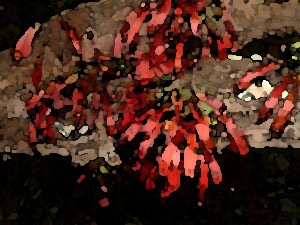
This admittedly attractive imposter is actually a member of the Scrophulariaceae, or Snapdragon Family, and is one of the few woody trees in that considerable family of mostly herbaceous plants. It's found throughout South Africa and ranges from there through Zimbabwe to as far north as Ethiopia. It's also known as African Honeysuckle or Notsung. Its orange-yellow flowers are tubular in shape and are distinctive in being borne in clusters directly off the woody trunk or branches. The fruit is edible but, while it's not generally considered to be particularly tasty, does have some traditional medicinal use in Africa, along with the leaves. It has an attractive willowy shape and can eventually grow to fifteen meters, often with multiple trunks. Since the so-called "Tree Fuchsia" is moderately tolerant of drought, can accept positions in either full sun or partial shade, and survives a bit of frost possibly to 20 F (-7 C), Halleria placida is increasingly found in gardens with a Zone 9 Mediterranean climate. Beware this imposter, though; the true Tree Fuchsia, Fuchsia excorticata, is a native of New Zealand.
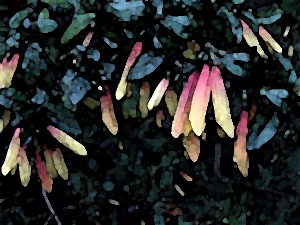
Since Brazil is home to eight of the nine fuchsia species in the Quelusia section, it seems more than a little absurd that some people should have taken to calling Justicia rizzinii the “Brazilian Fuchsia.” The “Brazilian” fuchsia is the fuchsia. But there you have it. Luckily, this member of the Bear’s Breeches Family (Acanthaceae) more commonly goes by “Firefly” or “Firecracker Flower,” or amusingly even “Candy Corn Justicia,” all of which suit it much better. It’s a small tropical evergreen shrub from about two to four feet tall (0.6-1.0 m) that’s suitable for pot culture in temperate climes in a sunny or bright position. The masses of attractive red flowers with yellow tips occur through the winter to brighten dark days. While not common as a houseplant, its equally attractive relative, Justicia brandegeana or the “Shrimp Plant,” is seen much more. Libonia floribunda and Jacobina pauciflora or floribunda are synonyms.
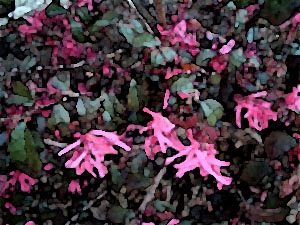
One of the banes of botany is the use of another unrelated genus within a cultivar name. The proscription is a sensible one intended to minimize taxonomic confusion. Fuchsia, of course, is frequently used these days to mean the fashion industry’s brightest and flashiest pinks so it’s now often stuck into plant cultivar names where magenta or hot pink would have formerly served just fine. So we’re treated to corporate sundaes like “Fanfare™ Fuchsia Trailing Impatiens” or “Moonlight™ Dark Fuchsia Zonal Germanium.” Usually these over-weight titles don’t cause much confusion as the reference to the fashionable hue is more or less clear. Sometimes the reference isn’t. ‘Zhuzhou Fuchsia’ is one of those times when the marketeers should have reigned in their overly colorful exuberance. This selection of the fragrant Chinese Fringe Flower is not an unattractive plant but it isn't actually what the unwary buyer often thinks it is. It may be hot pink but it’s not a Fuchsia; it’s a witch hazel (Hamamelidaceae). Anyway… The genus is monotypic, with only one species to it, and native to Japan and China. Loropetalum chinense is a fairly maintenance-free evergreen shrub that has an open horizontally layered, vase-shaped form which might eventually reach to 12 feet tall (4 m). It wants a spot with bright or high shade, if not full sun for the darker varieties, to maintain its shape and can even be trained as a small tree with the removal of lower branches. It’s hardy to Zone 7.
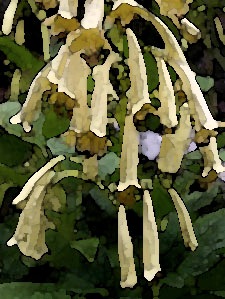
Another mimic, this time from the Snapdragon Family (Scrophulariaceae) and a relative of the North American penstemon, the "Cape Fuchsia" is a relatively cold-hardy perennial or sub-shrub native to South Africa adapted to withstand often harsh summer conditions. It's usually three to four feet tall and has a slightly sprawling habit. It's cut back where winters fall below freezing but can form large clumps a yard across from the running rootstock. In warmer areas, the "Cape Fuchsia" is semi-evergreen. It generally likes a warm summer position and the soil should be rich, but well-drained, especially in cold winter areas. British breeders and others are working with the only two species in the genus (Phygelius capensis and P. aequalis) and their crosses (P. x rectus) to improve characteristics such as cold-hardiness in the Northern Hemisphere and extend the range of forms for the garden. There are an increasing number of very attractive cultivars on the market. Even yellow ones. That's one color that has eluded fuchsia breeders so it does strike a note of envy. Dwarf and compact forms are now also available for pot culture.
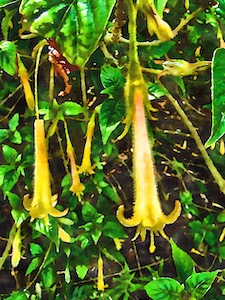
A member of the Coffee Family (Rubiaceae), Pseudomiltemia filisepala (Standl.) Borhidi is a close relative of another faux fuchsia, Csopodya splendens or the "golden fuchsia". Unlike its coffee cousin, though, this species may be rare but didn't go extinct when its last remaining stand was found cleared to pastureland. Endemic to the cool mountainous cloud forests of Chiapas and Oaxaca in southern Mexico, P. filisepala blooms primarily in the the winter and spring when its fuzzy two-inch fuchsia-like blossoms dangle gracefully from beneath the glossy ribbed leaves borne in whorls of three. The yellow blooms sometimes exhibit a red flush. Rare in the wild, P. filisepala is even more rare in cultivation. When it is grown, it prefers light shade with good air movement and mild summer temperatures. It's not frost hardy. It also requires consistently moist soil that mustn't dry out between waterings. The only other species in this genus is Pseudomiltemia davidsonii Mart.-Camilo & Lorence, which doesn't seem to have been tagged as a faux fuchsia of any kind yet. Perhaps because it was only first described in 2010.
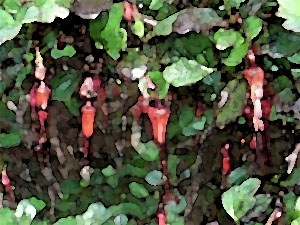
Another fuchsia hitch-hiker from California, this one is not even a distant relation to the real thing. Unlike Epilobium canum, it's not a member of the Evening Primrose Family, but a gooseberry that belongs instead to the Grossulariaceae, the Currant Family. The family now consists of only this single genus of about 150 to 200 species from the temperate parts of the Northern Hemisphere, most others having wandered off to join the Saxifrageae. To give the lingering Ribes speciosum its due, the elongated red flowers with their long protruding stamens and stigmas do vaguely resemble those of the fuchsia and are very pretty. R. speciosum occurs in part of the same range as Epilobium canum but is much more restricted. Natively, it grows in the scrub and chaparral coastal mountain ranges from Baja California to not much further north than above San Francisco in California. Sometimes to six feet tall by six feet wide, this shrub is very ornamental when used in gardens and prefers a position in dappled bright light. Be aware, though, of the three thorns at each internode and keep it planted nicely away from walkways. The fruit is an orange-red berry densely covered in bristles. It's hardy from Zones 7-9 but will die back to the ground if temperatures fall below 12 F (-11 C).
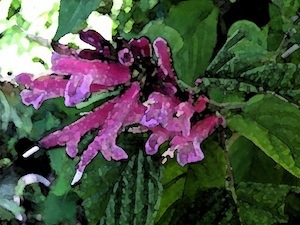
Hardy from about USDA Zones 8-11, Salvia idoantha is a large herbaceous perennial from about 3,000-10,000 feet in elevation (900-3,000 m) in the mountains of central Mexico. It grows four to six feet high, or more, and six feet wide and has bright magenta flowers in the late fall and winter. Hence the attempt to give it the fashionable appellation of fuchsia in the manufacturing of a common name after it started appearing in commercial horticulture in the 1980s. Or perhaps it’s the tubular flowers of the kind that seem to make people want to dub them a fuchsia in other locations. The flowers of this member of the Lamiaceae, or Mint Family, have a velvety texture. They’re not particularly large individually but their profuse masses make a striking statement. It’s also called the Scandent Mexican Sage, a descriptive name that’s arguably a better fit than a reference to flower color, as its flowering stems often grow up into trees and hang from the branches.
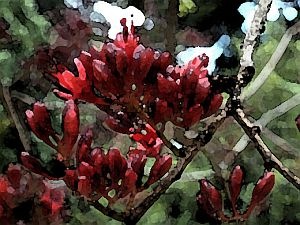
Schotia brachypetala is a flowering tree of the Pea Family (Fabaceae) native to sub-tropical southern Africa from Zimbabwe to South Africa. Luckily for any possible confusion with the true Tree Fuchsia (Fuchsia excorticata) or that other South African “Tree Fuchsia” (Halleria placida), the Schotia has developed quite a number of better names, such as the Weeping Schotia, Parrot Tree, Drunken Parrot Tree, Weeping Boerbean, Huilboerboon, and African Walnut. The amusing name of the Drunken Parrot Tree is based on the fact that the flowers contain so much nectar that it has a tendency to ferment within, resulting in a mild tipsiness in feeding birds. The “weeping" in some of the names again refers to the abundant nectar that often drips from the flowers rather than any tendency of the branches to droop. Easily grown as a medium to large spreading tree to 45-60 feet or more (15-20 m) with adequate moisture, the Weeping Schotia is widely cultivated and often planted as a street tree in appropriate places with a mild mediterranean climate, such as Australia, California or Spain. Pedestrians, and parked cars, beware!





